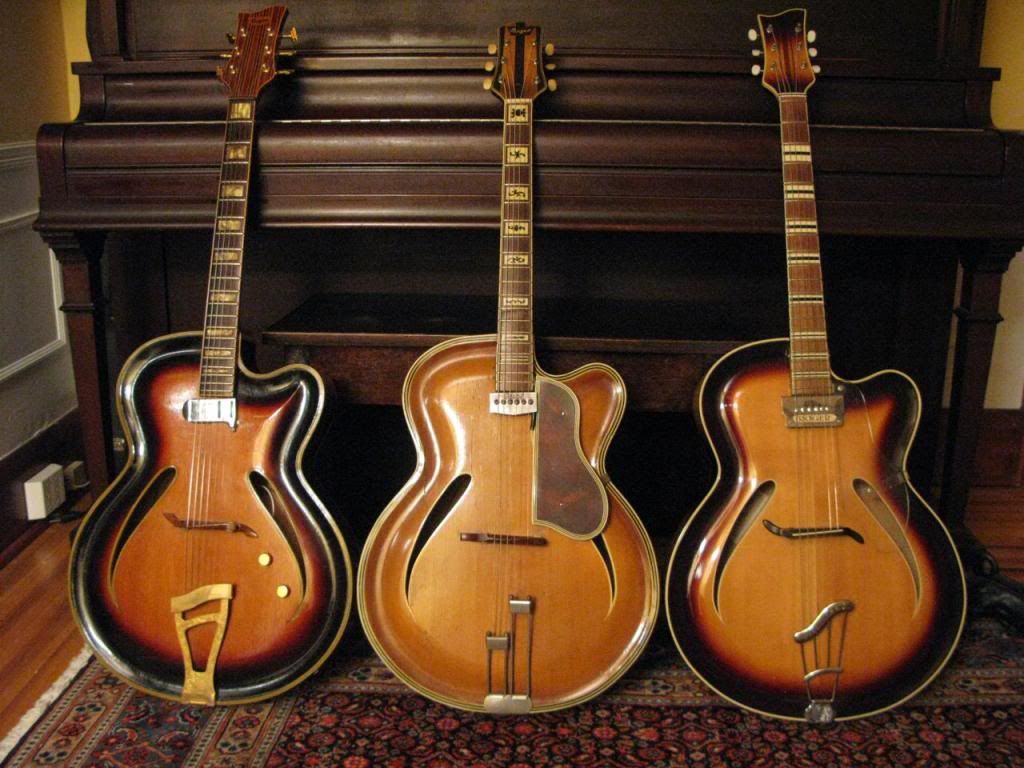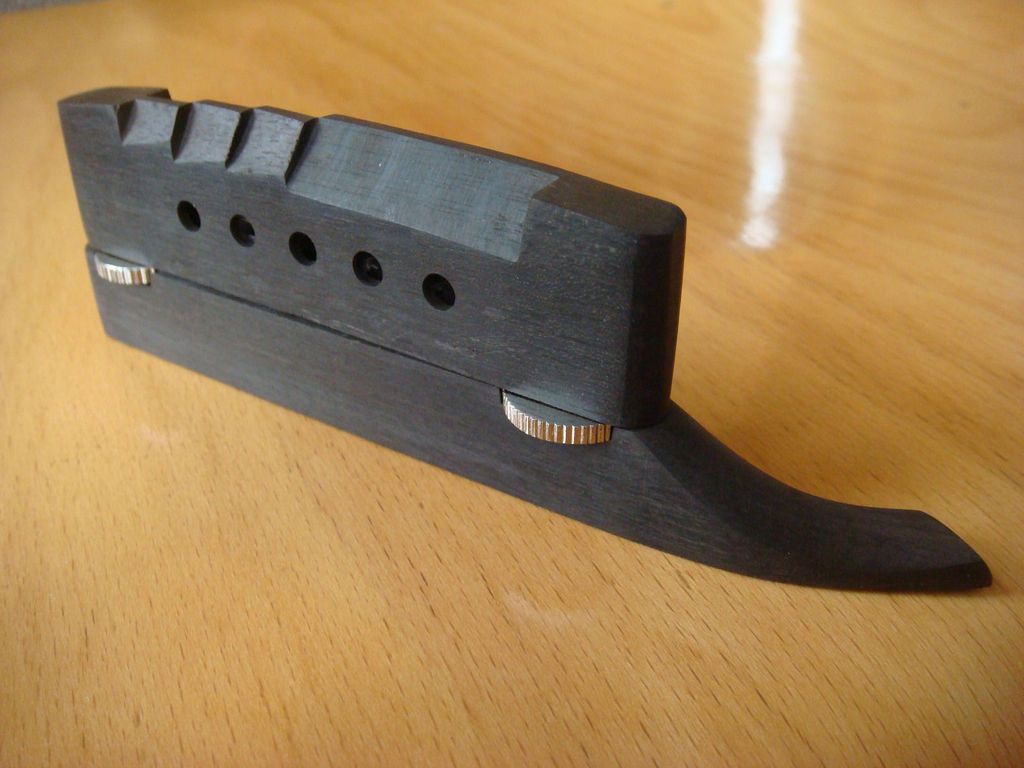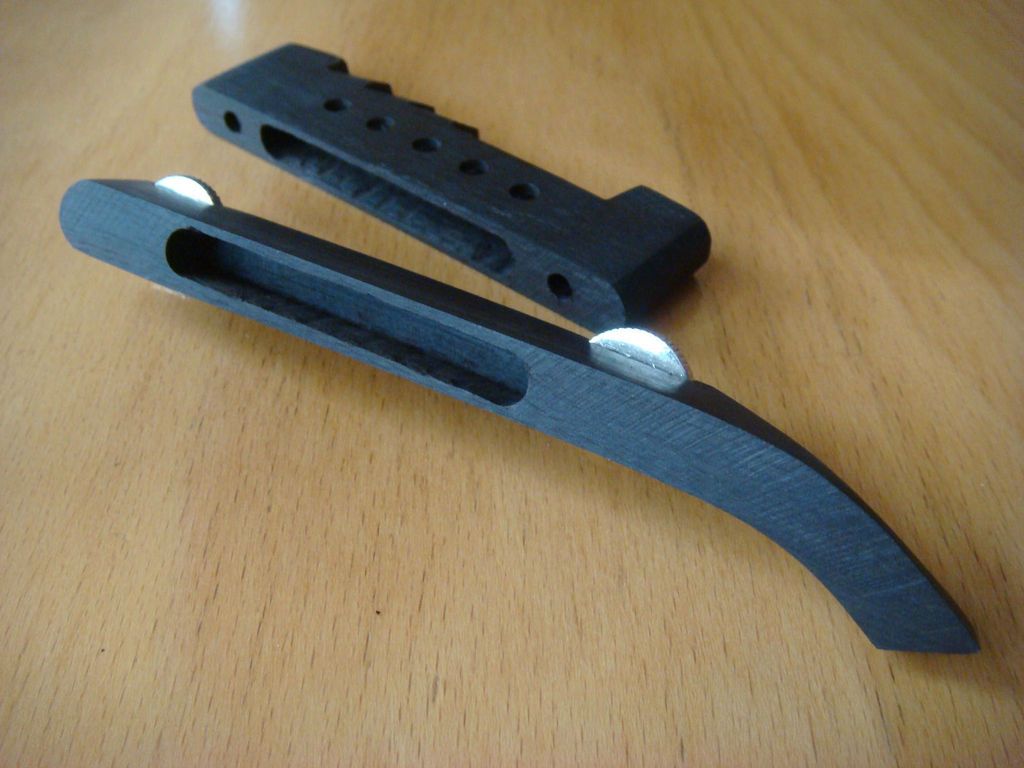-
After picking up a string of Italian guitars I thought it would be fun to try a German for a change.... I am sure many of you will know about the Roger guitars, and if you dont then just Google a bit. They were one of the better German brands in the 50s and 60s
as I have learned from an earlier post a couple years ago by Hammertone, this model was made in the mid 60s by Roger exclusively for a UK importer, and is quite different from other Roger guitars since it has a more traditional top arch, not the German carve. Probably pressed but certainly a solid top. Lovely tigerstriped sides and back.
judging from pictures of other Rogers I found on the net I assume that all parts are original and its as clean as a whistle too. Bridge is interesting, completely drilled and hollowed out just like John DA used to do on early 30s guitars
Sounds very loud and chunky. Reminds me a lot of my Epi Triumph, bit less refined and balanced but very nice midrange
if these guitars were better known / usa made then they would sell for a fortune. I tried many German guitars on guitar shows most were budget instruments and werent all that special , but this is a great sounding accoustic
-
07-01-2015 04:41 AM
-
Some pics
-
-
sehr schön.
-
Cool! The nut's a nice touch.
-
Yeah - it's interesting how many of these 1950s-60s Eastern German guitars had multi-band nuts. There are a lot of them.
 Originally Posted by Jehu
Originally Posted by Jehu
-
Not Eastern German !!!
Wenzel Rossmeisl who built these guitars was in Mittenwald, in Bavaria underneath Munich. Very much western Germany
He named the guitars after his son Roger, who later designed guitars for Rickebacker and Fender
-
Interesting saddle with the holes drilled through it. Congrats.
-
 Originally Posted by fws6
Originally Posted by fws6
Your guitar is indeed West German. Looks to me like a Roger Junior.
The model itself was first part of the Roger line-up in the post-war period in East Germany at Markneukirchen and possibly Berlin.
Congrats! I am envious. I would love to try a Roger!
FWIW.... Based on my research earlier this year (lots of it on www.schlaggitarren.de) on all things Roger and Musima (because I found a weird and wonderful German carve guitar labelled Roger but which was a Musima and went totally overboard for a short while), I think one could probably consider Wenzl Rossmeisl, the person, part of the eastern German, and later East German guitar luthiery movement. I expect that if he hadn't left East Germany following his period in jail (after his company/works at Markneukirchen and Berlin (in the GDR) had been confiscated to boot) in the early 50s, he might actually have stayed there - Markneukirchen was near his birthplace (on the other side of the border in what is now Czech Republic). But yes, more properly.... most of his career was in eastern Germany, which only became East Germany after the war - and he only spent 10yrs there before leaving the GDR and hopping over to Mittenwald.
In any case, a bunch of the guitars from that period - from both East and West Germany - have interesting nuts like that. I think they're quite cool.
I expect Hammertone can chime in with much more detail...
Most everything I have learned about Roger guitars has come from his posts, the euroguitars.co.uk forum, the schlaggitarren.de website, and related sites. It seems like an enormous amount of the knowledge on these guitars out there in English seems to originate from these sources.Last edited by travisty; 07-01-2015 at 08:47 AM.
-
Roger that!
-
Yes, all that private business was nationalized and became "Volks Eigener Betrieb", abbrivated "VEB". The quality of the goods produced usually went steeply downwards. That was seen in the German center of watch production, Glashütte, where former high class brands like Lange & Söhne rapidly were tranformed into "bric a brac". After 1989, the same companies have had another revival, and these days Glashütte watch brands like Lange & Söhne and Glashütte Original are up there along with the most prestigeous Swiss brands. Many new or revitalized eastern German companies could buy "VEB" machinery for a reasonable cost from the "Treuhandsanstalt" after the breakdown of the DDR in 1989. One of my favorite micro watchmakers, Dirk Dornblüth in Kalbe i/SA, has several "VEB" marked machines in his workshop.
 Originally Posted by travisty
Originally Posted by travisty
-
Very Cool Guitar.
Anxious to hear how it sounds.
Thanks for sharing.
Joe D
-
1930s, 1940s, 1950s, 1960s.
 Originally Posted by fws6
Originally Posted by fws6
This is a Roger Junior specifically designed for the British market, with a unique label, pressed solid spruce top and pressed laminated back. Originally Posted by fws6
Originally Posted by fws6
Roger archop guitars are directly comparable to 17" Gibson and Epiphone acoustic archtops of the '30s, '40s and '50s in several ways, including materials and sound quality. More to come... Originally Posted by fws6
Originally Posted by fws6
-
Thanks. The Roger company essentially started in Berlin in the 1930s, prior to any East/West divide. Post war, it was located in West Berlin. While Wenzel Rossmeisl set up a shop in Markneukirchen, East Germany to supply parts and instruments, the company is essentially West German, and Wenzel maintained his shop and offices in West Berlin.
 Originally Posted by travisty
Originally Posted by travisty
Wenzel Rossmeisl generously donated the Markneukirchen shop by to the Workers' Paradise from his jail cell after the Commies arrested him. That shop and others essentially became Musima. The Berlin shop continued to operate until Wenzel's son Roger drove it into bankruptcy and fled the country. After Wenzel's release from the hospitality of the Stasi in 1954, the Roger company re-started production @1955 in Mittenwald (West Germany), before moving to Neumarkt St. Veit (West Germany). In the late 1960s he moved to Munich (West Germany), from where ran a musical instrument distribution and retail business, along with helping set up Eko in Italy.
I think it's way more useful to view the post-war Roger Company as West German as opposed to East German. More later.Last edited by Hammertone; 04-25-2017 at 10:10 AM.
-
Thanks Hammertone for clearing that up.
I had simply assumed that his arrest and inprisonment was due to citizenship in East Germany as all this was pre-Wall. The other things I read about Markneukirchen tended to suggest there was more going on there than just parts but perhaps I read too much in between the lines. Musima certainly picked up the pieces there pretty well.
I actually remember looking up on a map the location of one of his offices in Berlin and finding it was in West Berlin near the
Potsdamerplatz.
I will dig some more!
-
Great looking guitar! Congrats on your new guitar day. NGDs are just so damned great . . aren't they?
I too am curious about the hole on the saddle. Decrease mass? Sound ports? But, on a more serious note . . if they were in some way able to release any sort of sonic vibrations/resonance . . . would that be directly picked up by the section of strings between tail piece and saddle . . . causing an audible sympathetic vibration? Probably not . . . but, I'd love to hear from a knowledgeable builder here on the forum, his opinion on that.
But, on a more serious note . . if they were in some way able to release any sort of sonic vibrations/resonance . . . would that be directly picked up by the section of strings between tail piece and saddle . . . causing an audible sympathetic vibration? Probably not . . . but, I'd love to hear from a knowledgeable builder here on the forum, his opinion on that.
Seven piece neck . . nine if you include the head stock wings. I'd very seriously doubt that neck would even have any sort of a roller coaster twist to it.
What is the overall weight like?
-
here's a DAngelico bridge from the 30s he also drilled holes and hollowed out the saddle from underneath to reduce mass. He abandoned the idea very quickly though
 Originally Posted by Patrick2
Originally Posted by Patrick2
-
2,7 kg (which is 5 pounds 14 onces)
 Originally Posted by Patrick2
Originally Posted by Patrick2
-
Very nice instrument. Congratulations, and play it in good health!
-
 Originally Posted by fws6
Originally Posted by fws6
Pretty sure I played that exact guitar twice at the time it was for sale. It was sitting in a certain place for some time and knowing your previous areas of purchase, I assume its the same one ;-)Last edited by Archie; 07-01-2015 at 04:35 PM.
-
Before the war, Wenzel had instruments built for him in Schonbach (Czechoslovakia), to his specifications, by Franz Hirsch. Wenzel had seen the Gibson L-5 and was inspired to develop instruments of similar style and quality. Very few of these survived WWII, there are only a few photos of these guitars, and only a handful of extant examples.
 Originally Posted by travisty
Originally Posted by travisty
After the war, Wenzel changed his design to incorporate the "German carve", and stopped sourcing his instruments from Franz Hirsch. He not only continued to operate his office/shop in Berlin, but also set up in Markneukirchen to build complete guiltars. He bought an existing shop there, including wood supplies, from well-respected luthier Peter Harlan. There was a supply of skilled luthiers there (look up the history of Markneukirchen), costs were lower (look at a map), and the intent was to sell the instruments through the West Berlin location, where Roger instruments were being built after the war, and continued to be built.
Guitar parts and posibly complete guitars were made in Markneukirchen and unofficially teleported to Berlin. The first "official" run of Markneukirchen instruments was seized, along with everything else, Wenzel included, during the Leipzig Music Fair in the spring of 1951. Thomas Buhé was able to save @10 guitars from the booth. The rest of the parts, still in Markneukirchen, disappeared.
A year later, MUSIMA was created by the commies as a “volkseigener Betrieb”(VEB), using the buildings, staff and inventory generously donated by three previous shops, of which Wenzel's was one. Over the years, various guitars have appeared that are clearly from the inventory of seized or "disappeared" guitar parts, without Roger markings, or were built using Roger-built parts. Musima introduced the Record and Spezial models - some of the early ones used leftover parts, but later Musima versions of those instruments for the most part became degraded and inferior versions of Roger guitars.
In Berlin, Wenzel's son Roger did continue to run the shop and build Roger guitars, but by September of 1953 he had driven the company out of business and fled to the US. Wenzel was released in April 1954, but the company was gone. He restarted it in 1955 in Mittenwald.
Read the article by Herbert Rittinger. It's pretty comprehensive.
And read the Roger thread over at the Euro Guitar Forum [ed. that forum is gone, for now]. It nicely captures the learning curve on these guitars from 2009 to now.
Below are three Roger Supers:
- on the left, built in Markneukirchen (non-original TP, tuners, pickup & controls);
- in the middle, built in Berlin, probably by Roger Rossmeisl (later pickup added);
- on the right, one of the "disappeared" ones, completed by Klaus Andrees.

Last edited by Hammertone; 10-11-2020 at 06:24 AM.
-
-
Fascinating.
The holes and hollowing of the bridge have to be some attempt to "tune" it to some degree the way violin makers do. Without direct knowledge or experience, I would guess that the aim was to balance the strings and eliminate harsh resonances.
So it probably IS to reduce weight, but probably NOT strictly for weight's sake. It would be for tonal balance. Obviously, removing such a small amount of wood has very little effect on the total weight of the guitar. A few grams? So it has to be more for tone. In his books the violin maker Henry Strobel describes the cause of wolf tones to be that some part of the instrument is too light or too heavy compared to some other part.
-
My guess is that Wenzel Rossmeisl adopted this approach to make his guitars sound "better," not to make them lighter.
-
Any thoughts on why he might have might have felt that this would make his guitars sound better?
 Originally Posted by Hammertone
Originally Posted by Hammertone




 Reply With Quote
Reply With Quote









Gibson Thin line Guitar Models
Yesterday, 11:07 PM in Guitar, Amps & Gizmos